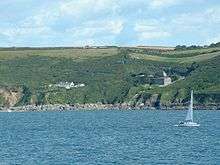Rame, Maker-with-Rame
Coordinates: 50°19′29″N 4°12′48″W / 50.3246°N 4.2133°W
Rame (Cornish: Hordh) is a hamlet between Rame Head and the village of Cawsand in South East Cornwall. It is situated on the Rame Peninsula. Rame means the high protruding cliff, or possibly, the ram's head.
Originally Cawsand was in the parish of Rame, but now has its own church in the village. The neighbouring church at Maker is in the same parish as Rame. Together they are called 'Maker-with-Rame' parish. Rame was recorded in the Domesday Book (1086) when it was held by Ermenhald from Tavistock Abbey. There were 27 households, land for 6 ploughs, 10 acres of pasture and 30 acres of underwood.[1] An electoral ward bearing the name of Rame exists. The population at the 2011 census was 4,763.[2]
There is another Rame near Falmouth in west Cornwall. It is believed that the west Cornwall Rame was named after the one on the Rame Peninsula.
During his time in command of the Channel Fleet between 1805 and 1807 John Jervis, 1st Earl of St Vincent rented a house in Rame.
Parish church


The church in the hamlet is dedicated to St. Germanus, the fighting bishop who is supposed to have landed in the neighbourhood when he came to Britain to suppress the Pelagian heresy in 400. It is all built of rough slate: the present stone building was consecrated in 1259. The slender, un-buttressed tower with its broached spire (an unusual feature in a Cornish church), the north wall and the chancel are all probably of this date, when the church was cruciform in shape. A south aisle was added in the 15th century and the Norman tympanum is a relic of the earlier church building on the site.[3] The church is not supplied with electricity, and is lit by candles.
See also
References
- ↑ Thorn, C., et al., eds. (1979) Cornwall. (Domesday Book; 10.) Chichester: Phillimore; entry 3,3
- ↑ "Ward population 2011". Retrieved 11 February 2015.
- ↑ Pevsner, Nikolaus, Cornwall: The Buildings of England, 2nd ed. rev. by E. Radcliffe, Penguin Books, 1970.
External links
![]() Media related to Rame, Caradon at Wikimedia Commons
Media related to Rame, Caradon at Wikimedia Commons
